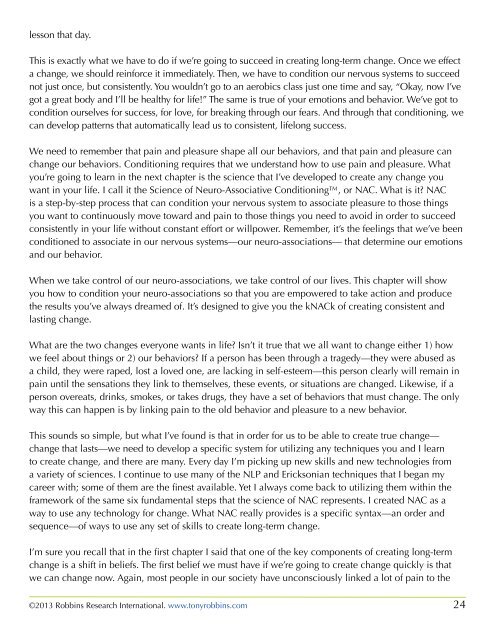Tony Robbins -Re-Awaken_the_Giant_Within
- No tags were found...
You also want an ePaper? Increase the reach of your titles
YUMPU automatically turns print PDFs into web optimized ePapers that Google loves.
lesson that day.<br />
This is exactly what we have to do if we’re going to succeed in creating long-term change. Once we effect<br />
a change, we should reinforce it immediately. Then, we have to condition our nervous systems to succeed<br />
not just once, but consistently. You wouldn’t go to an aerobics class just one time and say, “Okay, now I’ve<br />
got a great body and I’ll be healthy for life!” The same is true of your emotions and behavior. We’ve got to<br />
condition ourselves for success, for love, for breaking through our fears. And through that conditioning, we<br />
can develop patterns that automatically lead us to consistent, lifelong success.<br />
We need to remember that pain and pleasure shape all our behaviors, and that pain and pleasure can<br />
change our behaviors. Conditioning requires that we understand how to use pain and pleasure. What<br />
you’re going to learn in <strong>the</strong> next chapter is <strong>the</strong> science that I’ve developed to create any change you<br />
want in your life. I call it <strong>the</strong> Science of Neuro-Associative Conditioning, or NAC. What is it? NAC<br />
is a step-by-step process that can condition your nervous system to associate pleasure to those things<br />
you want to continuously move toward and pain to those things you need to avoid in order to succeed<br />
consistently in your life without constant effort or willpower. <strong>Re</strong>member, it’s <strong>the</strong> feelings that we’ve been<br />
conditioned to associate in our nervous systems—our neuro-associations— that determine our emotions<br />
and our behavior.<br />
When we take control of our neuro-associations, we take control of our lives. This chapter will show<br />
you how to condition your neuro-associations so that you are empowered to take action and produce<br />
<strong>the</strong> results you’ve always dreamed of. It’s designed to give you <strong>the</strong> kNACk of creating consistent and<br />
lasting change.<br />
What are <strong>the</strong> two changes everyone wants in life? Isn’t it true that we all want to change ei<strong>the</strong>r 1) how<br />
we feel about things or 2) our behaviors? If a person has been through a tragedy—<strong>the</strong>y were abused as<br />
a child, <strong>the</strong>y were raped, lost a loved one, are lacking in self-esteem—this person clearly will remain in<br />
pain until <strong>the</strong> sensations <strong>the</strong>y link to <strong>the</strong>mselves, <strong>the</strong>se events, or situations are changed. Likewise, if a<br />
person overeats, drinks, smokes, or takes drugs, <strong>the</strong>y have a set of behaviors that must change. The only<br />
way this can happen is by linking pain to <strong>the</strong> old behavior and pleasure to a new behavior.<br />
This sounds so simple, but what I’ve found is that in order for us to be able to create true change—<br />
change that lasts—we need to develop a specific system for utilizing any techniques you and I learn<br />
to create change, and <strong>the</strong>re are many. Every day I’m picking up new skills and new technologies from<br />
a variety of sciences. I continue to use many of <strong>the</strong> NLP and Ericksonian techniques that I began my<br />
career with; some of <strong>the</strong>m are <strong>the</strong> finest available. Yet I always come back to utilizing <strong>the</strong>m within <strong>the</strong><br />
framework of <strong>the</strong> same six fundamental steps that <strong>the</strong> science of NAC represents. I created NAC as a<br />
way to use any technology for change. What NAC really provides is a specific syntax—an order and<br />
sequence—of ways to use any set of skills to create long-term change.<br />
I’m sure you recall that in <strong>the</strong> first chapter I said that one of <strong>the</strong> key components of creating long-term<br />
change is a shift in beliefs. The first belief we must have if we’re going to create change quickly is that<br />
we can change now. Again, most people in our society have unconsciously linked a lot of pain to <strong>the</strong><br />
©2013 <strong>Robbins</strong> <strong>Re</strong>search International. www.tonyrobbins.com 24


